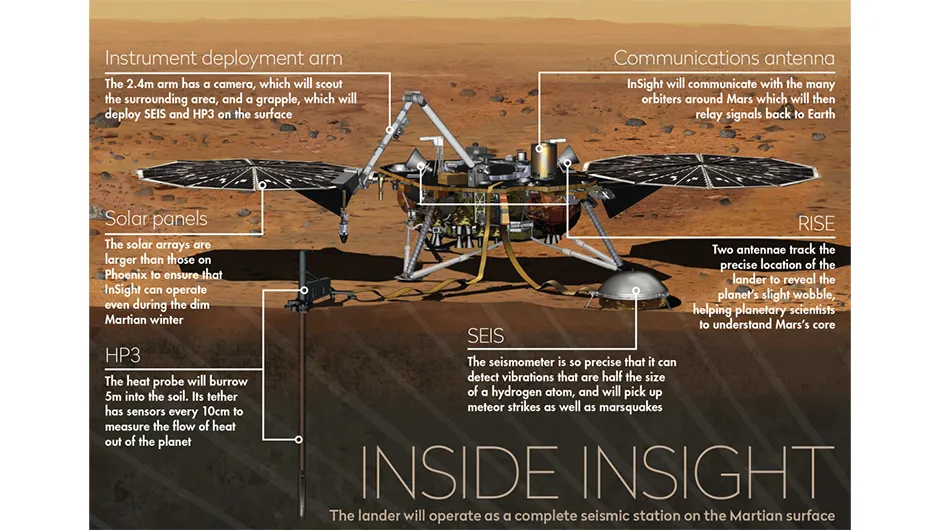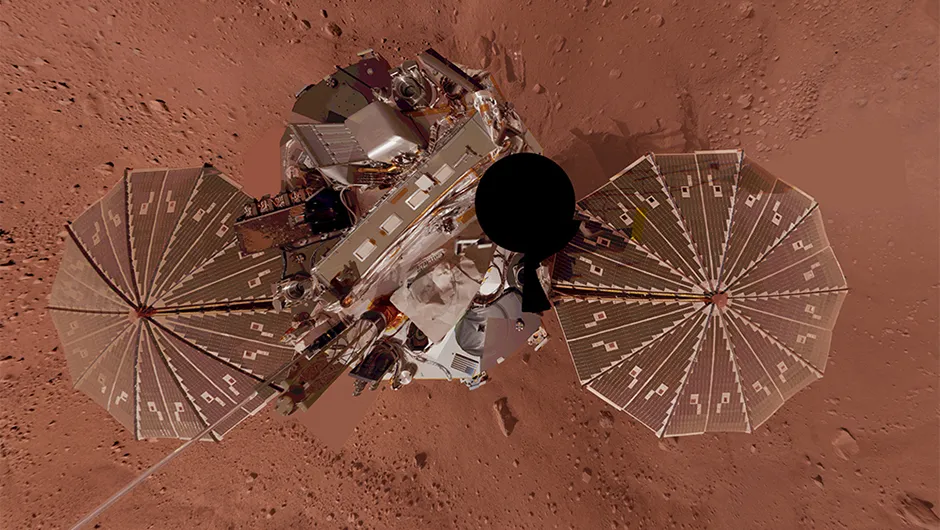Dozens of robotic explorers have been sent to Mars over the decades, but so far most of them have done little more than scratch at the surface.NASA’s Insight (Interior Exploration using Seismic Investigations, Geodesy and Heat Transport) mission, however, will look much deeper into the planet than any of its predecessors.
The InSight lander is preparing to hunker down on the Martian surface, ready to take the planet’s pulse and temperature, and peel back its layers to expose its very core.
The mission launched early May 2018 from Vandenberg Air Force Base, California, arriving at Mars six months later to send a static lander to the surface on 26 November.
This isn’t the first time NASA has put down a probe like InSight.
“We tried to stick to the design of a previous lander, Phoenix, as much as possible,” says Suzanne Smrekar, Deputy Principal Investigator of InSight.
“First, we have an aeroshell that will slow us down when we hit the atmosphere.
Then we have a parachute to take us most of the way through the atmosphere.
Finally, for the last little bit we come down on rockets.”
InSight will spend its first 10 weeks setting up.
Its first task will be unfolding its solar arrays so that it can supply power to the lander.
Then the mission will look around for the best place to put its fingers to the ground, so that it can feel for marsquakes – tremors created by the shifting of internal rocks, which radiate out from deep within the planet.
“Our primary instrument is a seismometer, the Seismic Experiment for Interior Structure (SEIS),” says Smrekar.
“It actually has several short and long period seismometers to measure nearby seismic waves and those that come from deeper within the planet respectively.
We have three of each so we can tell the direction and orientation that they are coming from.”
Measuring marsquakes
These seismometers are so sensitive that they have to be covered over with a dome that will protect them from tiny shakes caused by wind or thermal expansion to make them as precise as possible.
Such accuracy is vital in marsquake measurements to detect the tiny changes that occur when a seismic wave travels between the different layers inside the planet – going from the viscous fluid of the mantle to the solid crust, for instance.
By looking for these tiny variations, planetary geologists will be able to work out the thickness and density of each layer, building a map of the world beneath the Martian surface.
Gathering this knowledge is the first step to understanding how Mars grew and evolved into the planet we see today.
“We’re trying to understand what happens immediately after the planets came together.
"The heat of that kinetic energy caused the bodies to melt and then relatively rapidly, within 10 million years, they began to form their initial layers as light stuff floated to the top and heavy stuff sank to the bottom forming the core, mantle and crust: a process called differentiation,” says Smrekar.

Stunted growth
The extent to which a planet differentiates is mostly defined by how much heat it has, and how hot a planet is mostly depends on its size.
Small rocky bodies like the Moon rapidly cool after they form and so never fully differentiate their interior.
Meanwhile Earth has kept evolving for billions of years because it’s been kept warm by the decay of radioactive elements.
As its interior is molten, the material there can redistribute itself inside the planet.
The liquid layers also allow the continental plates to move around, changing the topography of the surface, while liquid magma bubbles up from volcanoes and covers what was there before.
The end result is that Earth today bears little resemblance to the planet it was when it first formed billions of years ago.
The same processes are thought to play out on the other, larger terrestrial worlds, but Mars has some unique geological qualities.
“Mars is in this sweet spot: we think it’s in the right place in terms of its size that it never had plate tectonics, so it still has its initial crust, but it’s big enough that it has some of the same kinds of layers that we expect inside of the Earth,” says Smrekar.
Although Mars started out developing like a larger rocky planet, it cooled and froze very early in its lifetime, halting its growth.
As the planet hasn’t changed in billions of years, it now gives geologists a window into the early years of planetary formation.
And the key to understanding why Mars cooled while worlds like Earth didn’t is finding out how the Red Planet lost its heat.
To do this, InSight will deploy its second instrument, the Heat Flow and Physical Properties Probe (HP3).
“Most of the planet’s current heat budget comes from the decay of radioactive elements: uranium, thorium, potassium.
HP3 will help us extrapolate how much of those elements Mars had in the past, and how much energy there was to drive things like volcanoes on the surface of Mars, and what the surface temperature might have been,” says Smrekar.
Running on the spot
To take these measurements, HP3 will use a heavy probe to hammer itself up to 5m into the ground, pulling a string of temperature sensors behind it that will measure the heat flowing out of the planet.
Once everything is in place, the lander will cease all further movement so as not to disturb the two experiments.
Fortunately, the fact that the lander is static doesn’t matter – no matter where it comes to rest, it can measure heat flow and keep track of seismic signals. The immobility also benefits InSight’s third and final main experiment: RISE.
“The Rotation and Interior Structure Experiment (RISE) are radios that will communicate with Earth every couple of days over Mars’s year, tracking the placement of the lander very precisely,” says Smrekar.
“What we’re really doing with them is tracking the wobble of Mars as it spins on its axis, since planets with liquid cores wobble more than planets with solid cores.”
By measuring the wobble, planetary geologists will be able to determine more accurately the density and consistency of each layer, which will help them work out what elements might make up the planet’s core.
By tracking back, the InSight researchers will be able to piece together the geological processes that went into creating the rocky world that Mars is today, and so how planets such as Earth might have looked before they were transformed by billions of years of volcanism and geological development.
InSight is expected to have finished its initial science goals within one Martian year (which at 687 days is just shy of two Earth years) but the team has built the lander to last, and hopefully InSight will continue gathering data long after its initial run.
It might even be able to detect the arrival of two fellow Mars explorers when they land: both NASA and ESA plan on sending rovers to the Red Planet in 2020, doubling the number of mobile observatories ranging across the planet’s surface.
But for the next two years, InSight will take advantage of the quiet, and sit waiting for Mars to shake out its hidden secrets.

Rising from the Phoenix
To those who follow Martian missions, InSight might look rather familiar.
That’s no surprise: it is closely based on the Phoenix lander, which touched down in Mars’s polar region on 25 May 2008.
The InSight team has borrowed the design for the lander’s descent hardware, base structure and robotic arm from Phoenix, but added a completely new set of science instruments.
This helped to reduce costs dramatically but also put several limits on the mission.
Phoenix only operated for six months, but InSight is designed to last for at least a Martian year, if not longer.
This means it has to land on the equator, or the solar panels won’t be able to collect enough power during the dim winter months.
In addition, the descent systems will only work over a certain range of altitudes and the only place on the equator at the right elevation is the flat Elysium Planitia region.
The Phoenix mission itself was concerned with the surface, rather than what lay beneath, and attempted to find out how hospitable the Martian soil was to life, past or present.
The robotic arm took soil samples that were then heated, revealing they contained water ice, and the chances of habitability initially looked bright.
The excitement was short-lived as Phoenix also found perchlorates, a chemical that reduces the freezing point of water.
While this could mean it is possible for liquid water to exist on the surface, when combined with other minerals and subjected to Martian levels of ultraviolet radiation, perchlorates cause a 10-fold increase in cell death.
If any life did evolve on Mars, it would have found itself in a very hostile environment.
